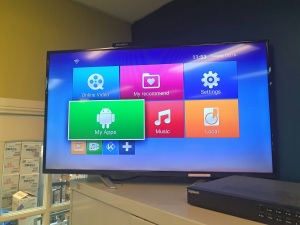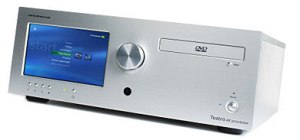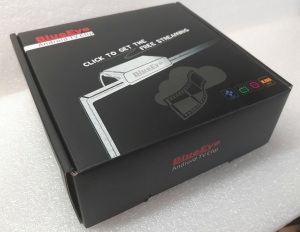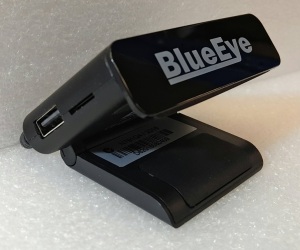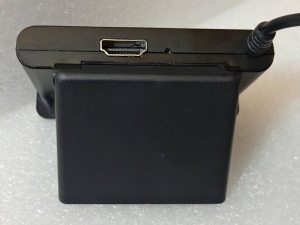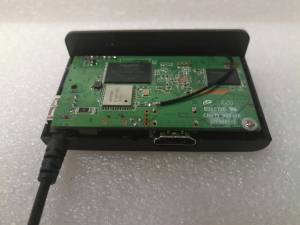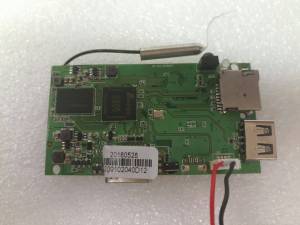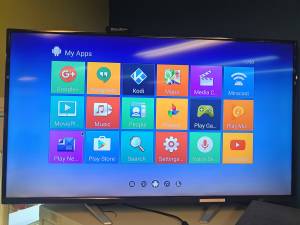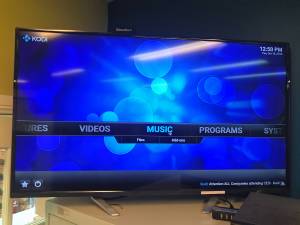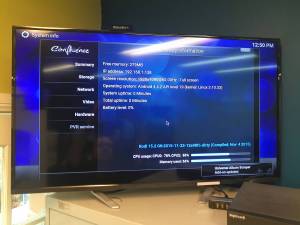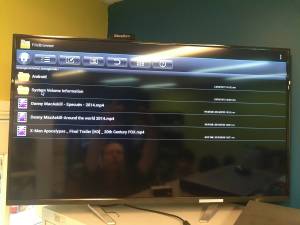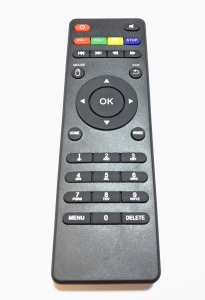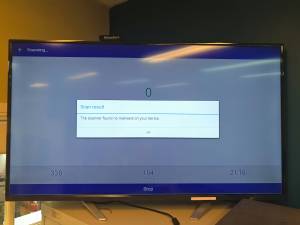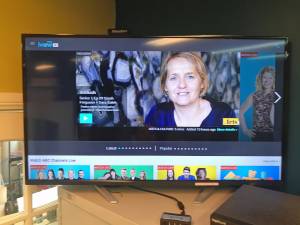BlueEye D6 Android Media Player Review
Possibly one of the smallest TV media players I’ve seen turned up at my office today – can you see where it’s hiding in this pic?
Yup – it’s that tiny box perched on top of the TV – and it’s powered by the TV too. Read on to see why the BlueEye might be worth parking on top of your TV.
Android Media Players 101
Getting your collection of movies and music onto your TV used to need a full-fat PC worth as much as a used car – they were called “Media Centers” and for a time Microsoft supported them with a dedicated Operating System called “Windows Media Center” (which later became an add-on to later versions of windows until it got dropped with Win10).
However, the relentless development of low-power CPUs that were intended for phones and tablets has recently spawned a new way to make your older dumb TV into a smart one. These multi-core Computers-on-a-chip can be easily turned into useful TV-watchers with Google’s Android, the O/S that runs more than 85% of the world’s smartphones, and voila, you can have a cheap customisable PC running your TV and delivering all your video content for a just a few watts.
Android’s easy-to-use interface, combined with a simple remote and an internet connection means you can play movies from attached USB disks, or stream from the internet (Netflix, Presto etc), or from other PCs/network devices at home, all on a device that’s well under AU$100 delivered. Android also has a Windows Media Center app replacement called KODI that does more than WMC did in it’s day, and it’s free and extensible with many user-developed plugins.
I’ve seen plenty of other small media players – what’s special about this one?
Yes – there are plenty of “stick” media players that plug-in directly to a HDMI port on the back of a TV, but this almost always means that you have no way to control them via remote, as they are hidden behind the TV, and that means no IR signals can be received, necessitating an RF or BT keyboard/remote that will cost as much as the BlueEye itself. The cunning minimalist design of the BlueEye means that it’s IR receiver “eye” is always going to have a good view in front of the TV, where you will be sitting and using the included remote.
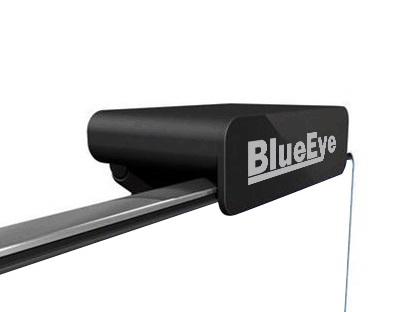
It’s powered by USB, and the average recent TV will be capable of providing that power, so you just need to plug it in to the USB and HDMI ports on your TV to get it working.
The small box fits into a 500gram Express bag, and contains just the player, the remote, USB-power 1.5A 5V wall-plug, and a quick-start guide. You’ll need to scare up a HDMI cable and two AAA batteries for the remote (Avoid the home-brand AAAs from Costco, as their dome-tops don’t stick out far enough to make proper contact in many devices, I’ve found).
Minimalist design
The side view here shows the single USB input port, and the thin slot for Micro SD memory cards. Any card you insert ends up almost flush with the side, so you need to keep one fingernail unbitten to eject them. There’s some rubber inserts on the clip to make sure it can grab the top of a TV properly.
The back has a single HDMI port (V1.4, does up to 1080P at 60Hz), and the cable exiting the back to plug it into the TV for USB power is about 1.2m long.
The folding bit is the clamp that helps the BlueEye cling to the top of the TV. It’s not very firm, but even with the weight of HDMI / USB cables pulling it down, it stayed clipped to the top of my Dick Smith TV (R.I.P.). The tiny hole next to the HDMI port accesses a reset switch you can press in case a wonky app makes the player stop responding.
The giblets within
As always, I like to get inside things to see how they are made – this one’s case was clipped together on the sides, and there was one Philips screw hiding under a bit of rubber on the front corner.
There’s just one PCB inside, and it’s populated on both sides. This side has the WiFi antenna wire, a SanDisk flash memory chip (8Gb total, 4.7Gb available for your stuff), and one of the two Nanya RAM chips.
The other side has the AMlogic S805 Quad-Core CPU, another RAM chip, and all the I/O ports (from the top-right: IR receiver, power-LED, card-reader, USB, Power, reset, and HDMI).
The included 1.5A 5v power supply suggests it can’t consume more than 7.5watts, though I suspect it will actually run on far less than that, given the USB output on the TV is only 500mA. You could leave it on all the time and it would use almost no power to speak of, compared to a PC.
How does it work?
Once I’d plugged the BlueEye into the TV’s USB and HDMI ports, it booted up within 30 seconds, and was ready to play. Just use the D-Pad on the remote to move between the icons and press OK to launch them. Connect to your WiFi router and you are ready to stream content or browse the web.
If you’ve got a Google account, use the remote to find the Play icon in My Apps, and you can sign in and download more apps. A keyboard will pop-up when text fields need your input.
Whilst you can enter text with the remote, it’s slow, and for initial sign-in, WiFi passwords, and advanced customisation, I’d suggest attaching a USB keyboard to speed things up – it recognised a regular desktop keyboard, and a Riitek wireless keyboard/mouse dongle without any issues – the Android “Go Back” command is the ESC key in a PC keyboard, by the way.
If playing movies or streaming video from overseas is your thing, KODI will do that, and it’s pre-installed.
KODI has a huge number of plug-ins you can add to bring more content in – the first time you fire it up, it will go and check all of them for updates and so on. AddOn Installer was pre-installed, which is a kind of app-store for KODI, which simplifies finding more plugins.
If you plug in a USB drive, you can manage it and launch movies directly via the FileBrowser app. I tested it with thumb drives and mains-powered USB spinning disks up to 2Tb – spinning disks that only have USB power (such as ones with laptop 2.5inch drives inside) might draw too much power for the TV to supply – using the included power adapter, or a powered USB hub would solve this. There’s plenty of other file-managers available in the Play store, so if you want something to work across your network, try ESFileExplorer for example.
The IR remote has a selection of rubbery navigation buttons for moving selection boxes around the Android screens, and it can also be flipped to mouse mode, which gives you a slow-moving Windows-style mouse pointer for finer control.
There’s dedicated volume and playback buttons across the top, mute and power – it gets the job done, but if you want something more ergonomic, that can also control your TV and other HiFi gear and stop their remotes from cluttering-up your coffee table, consider getting the Logitech Harmony 650 and teaching it the functions that the BlueEye’s remote has.
Apps and compatibility
The Android install on the BlueEye is not rooted, so most apps should be fine with it, but like most other Chinese Android phones and tablets I’ve experienced, it won’t pass all the SafetyNet tests. This means some DRM-insistent apps like Android Pay may refuse to work, although you might get an odd look from the cashier if you try to pay for something by swiping a media player at an EFTPOS terminal. MalwareBytes found no issues and only warned that the O/S was able to install apps from sources outside Google.
Pay-TV services Netflix and Presto worked fine with the BlueEye, as did ABC’s iView and the other local free-to-air Australian TV channel streaming TV apps. If you want to watch foreign TV, there’s add-ons for KODI that do that. A recent H.265 movie trailer was fine also – this is a new CODEC that has a higher compression efficiency that prior CODECs, resulting in smaller file sizes or better quality for a given size.
There was no Chinglish evident in the menus, and no mystery Chinese-language apps. Unlike Apple’s AppleTV, the Android O/S is not a walled-garden, and it’s happy to let you bring in your own content, install random apps from USB sticks and modify how the interface looks and works.
Any alternatives?
Microsoft has abandoned Windows Media Center over a year ago – there are still some hard-core enthusiasts cobbling it back into Windows10, but it’s been waning in popularity for years, and many third-party apps such as Netflix were disabled a long time ago. Yes, you can install KODI on a Windows PC, but unless you want to do free-to-air via a TV tuner card, a full-fat PC will cost a lot more $$ to buy and a lot more power to run.
Before Android, there were several generation of media players that ran on a version of Linux – these are somewhat limited, in that they could only run the apps their factory baked into their firmware, there was no app store for them to install new apps from, and they can’t be customised to any extent – not many of these are left now, with the exception of a few dedicated ones that can do free-to-air TV reception, such as the Noontec series.
You can also run Windows10 on a lot of the low-powered computer-on-a-chip Atom-based PCs, and then run KODI on top of Win10, but to be frank, Win10 pushes up the price of the hardware, the interface is clunky compared to Android, it needs more resources, and is not optimised for use with remotes. If I had to pick one over the other for usability on a TV, Android wins every time.
